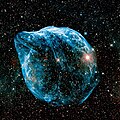| Emission nebula | |
|---|---|
 | |
| Observation data: J2000.0 epoch | |
| Class | 3 2 2 |
| Right ascension | 06h 54m 13s |
| Declination | −23° 55′ 42″ |
| Distance | 4530 ly |
| Apparent magnitude (V) | 7.0 |
| Apparent dimensions (V) | 35′ × 35′ |
| Constellation | Canis Major |
| Physical characteristics | |
| Radius | 30 ly |
| Designations | Sh-308, RCW 11, LBN 1052 |
Sh 2-308, also designated as Sharpless 308, RCW 11, or LBN 1052, [1] and commonly known as the Dolphin-Head Nebula, is an H II region located near the center of the constellation Canis Major, composed of ionised hydrogen. [2] It is about 8 degrees south of Sirius, the brightest star in the night sky. The nebula is bubble-like and surrounds a Wolf–Rayet star named EZ Canis Majoris. This star is in the brief, pre-supernova phase of its stellar evolution. The nebula is about 4,530 light-years (1,389 parsecs ) away from Earth, [3] but some sources indicate that both the star and the nebula are up to 5,870 ly (1,800 pc) away. [4] [5] Yet others indicate the nebula is as close as 1,875 ly (575 pc) from Earth. [6]





